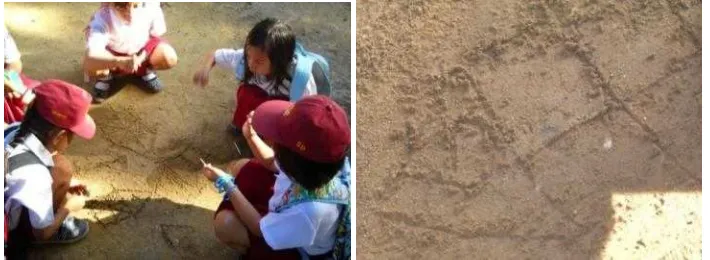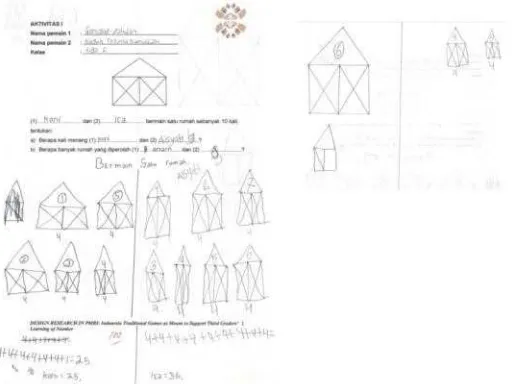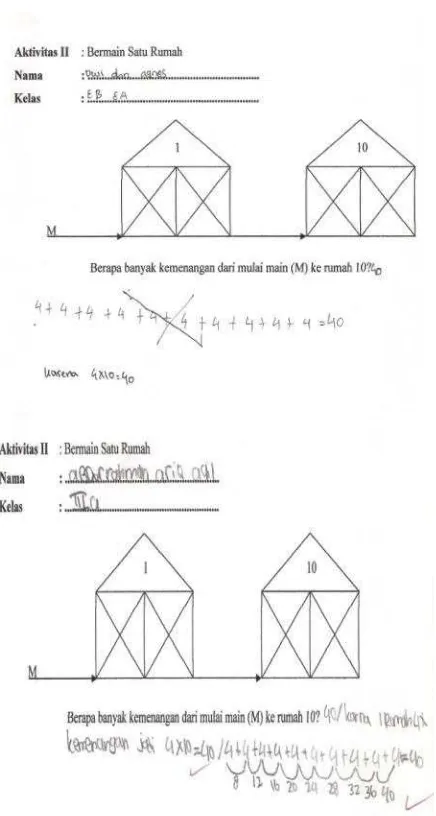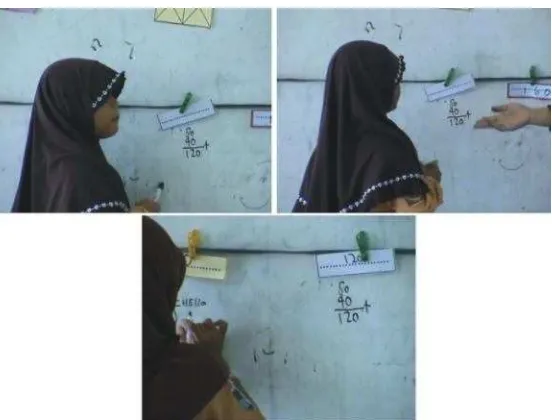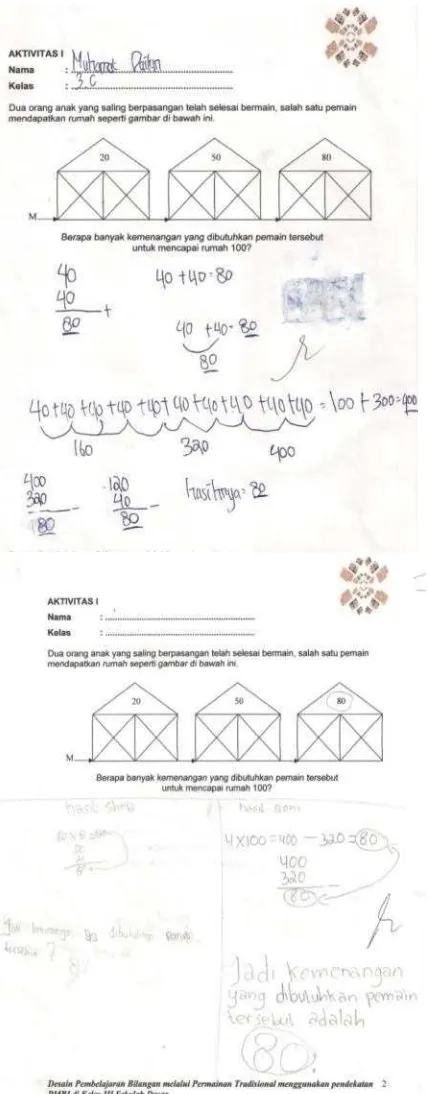41
Building counting by traditional game: A Mathematics Program for Young Children
Nasrullah, Zulkardi
Abstract
In line with design research, the use of Bermain Satu Rumah (BSR) as traditional game to support children’s counting classroom wherein students are encouraged to construct mathematical understanding. Number in traditional games is an interesting aspect that is helpful for children to encounter numerous situations that bring them into contact with sounds, symbols and meanings that relate to numbers. Bermain satu rumah as starting activity would be media to enhance student’s sense of number as well as to be used as learning material. By developing model-of problem of bermain satu rumah as traditional context, resultative counting is counting a number of things with the aim of determining how many are there (the result) that can be showed by using addition and multiplication concepts. Student’s thinking on their level exhibited us their successful conservation when they were in the last grade. The progress of understanding by game, especially bermain satu rumah, is concrete effort to support number learning in primary school. Using game in learning process, for instance, mathematics learning for primary school can be a mathematics program for young children.
Key words: Resultative Counting, bermain satu rumah, Mathematics Program
Abstrak
sekolah dasar dapat menjadi suatu program pelajaran matematika untuk anak-anak.
Kata kunci: Membilang resultatif, bermain satu rumah, program matematika
Introduction
Mathematics is a way of thinking (Reys, Robert E., Suydam, Marilyn N., & Lindquist,
Mary M., 1984). It provides us with strategies for organizing, analyzing, and
synthesizing data, largely but not exclusively numerical. That’s why mathematics
couldn’t be seen as a concrete object in order to make it real when people are talking
about it. Number becoming one thing that people always talk until now is an object
for mathematics. Number on mathematics is an object used to count and measure. In
early age of young children, the phenomenon of conservation of number reflects how
children think. Moreover, we will come true to the fact of number sense for children
when they used to solve their problem.
Traditional games can be the true example to show number used to support the rule of
games in daily life in Indonesia. The games are exciting activities not only for the
children, but also adults who need to get refreshing from their busy activities.
Indonesia is the rich country from traditional games, but it’s not clearly anymore to
make sure many children to do play traditional games. Since many modern games
come to Indonesia, many of them are gradually not to play the traditional games. They
like to play modern games, such as PlayStation, online game, etc. in which children
can do by their self without go outside of home (Nasrullah, 2011).
An impressive aspect of traditional games can be developed to support children
thinking when they are learning is number. It is related with mathematics for children
on primary level. Thus, number in traditional games is an interesting aspect that is
helpful for children to encounter numerous situations that bring them into contact with
sounds, symbols and meanings that relate to numbers (Treffers, 2001). Especially, if
they were learning mathematics, they would do counting through playing game.
Therefore, when they are in this situation, developing of number can be referring to
build their sense of number. By exploring the knowledge that they have after playing,
some model-of problems constructed into mathematics program is developed based on
by instructional rule of the game and by mathematical questions into cyclical learning
activities.
Traditional Game as Situational Material
The first example is taken from a teaching experiment in grade 3, where the students
we gave them situation to play a traditional game from Sulawesi. In this context,
students as player should understand the rule of playing game. When you want to play
BermainSatuRumah, you have to know some tools that are used. The first is usitan to
determine who has opportunity to draw crossing line on their rumah. Then, the players
have to know when they can move to the next rumah if they have completed their
crossing line based on how many of usitan that they need. It means the player who has
completed crossing line can move to the second rumah by putting number on each of
rumahs.
Figure 1. (Left) students are playing with their pairs, (Right) one of result of playing game is rumah with ordered number on the roof
The use of traditional game as starting point for learning process can be helpful to the
children developing counting skills (Reys, Robert E., Suydam, Marilyn N., &
Lindquist, Mary M., 1984). Today’s children have experienced many direct attempts,
primarily while playing game (e.g. BermainSatuRumah), to develop counting skills,
and classroom activities should be designed to build onto these experience. When the
students are facilitated to do activities like in the figure 1, then we ask them to
determine how many of crossing line that they have until the last. The student’s
Figure 2 would for instance be evidence that students mean to what they have about
ability of counting. Conservation of number that students did on their worksheet
reflects how they think about the problem. Koni wrote numbers under every rumah
that she got after playing with Ica as an opposite player. Conservation by writing
numbers for each of rumahs to show their thinking in order to determine how many
wins they get as long as they play. Before some numbers are added each other to find
out their wins on the game, we may think those numbers come from the numbers that
she wrote under each rumah.
Sense of number would be an important thing that influences the way of thinking in
Koni’s mind. She understood the magnitude of garisbersilangan, and then can
represent them as number. Although she can’t count all directly, Koni know what she
should do first. Adding by using addition becomes the next strategy to make sure how
many wins that she found.
Figure 2. One of student’s response developed by understanding of playing game
From playing game, either Koni or Ica has showed their thinking of counting. Belongs
to counting in form of numbers, sense of number becomes bridge to support their
understanding of conservation of attribute on the game. It means that
bermainsaturumah as starting activity would be media to enhance student’s sense of
Resultative Counting
The process of resultative counting can be seen as a synthesis of the development of
counting number and numerosity number (Gravemeijer, 1994). Counting a quantity
one-by-one to determine the total number (resultative counting) is a complex skill
developed by trial and error (Buys, p. 27 emergent numeracy). Combining both of
counting number and numerosity number is being supposed to combine both of
ordinal and cardinal numbers. So far we may think important considerations in
number development and described how children think about the numbers 0, 1, 2, .…
The emphasis has been on finding a correct number name for a given group. This
aspect of number, cardinal number, answers the question, “How many?” Another
important aspect of number emphasizes arranging strings in an order and is known as
ordinal number, it answers the question, “which one?”
Developing number needs fundamental knowledge in order to do resultative counting.
The ability of knowing attributes. According to learning structure, reference number
(numerals), counting number (number sequence), numerosity number (1 – 1
correspondence) are basis of fundamental knowledge which supporting resultative
counting that requires countable objects to map one by one on the number sequence,
Figure 3. Student’s strategies to solve problem model-of
Problem model-of developed by the result of playing games, like in figure 3 that
shows what students would do to solve the question “how many wins start from play
(M) to rumah 10?” In this case, two answer sheets showed the same answer, that is 40.
Although the answer is similar with both of them, they have various strategies to
determine the number 40. Dwi and Agnes used addition and multiplication concepts
to support their counting, and also Abdurrahman Ariq Aqil who even writes another
form like number line pattern to bridge his thinking before come to the number 40.
Based on Dwi and Agnes’ answer we may know that they interpret for every rumah
containing 4 wins. Because the question should be answered by showing wins for 10
rumahs, they wrote on the worksheet “4 + 4 + 4 + 4 + 4 + 4 + 4 + 4 + 4 + 4 = 40.”
this case, they exhibit their understanding of repeated addition as multiplication. It can
be seen below the number model that they wrote we may be understood the meaning
of “karena 4 x 10 = 40.” The crossing line that lies on the middle of Dwi& Agnes’s
answer may be evidence of doubtfulness, and the additional word of “karena” may be
the main reason to determine “how many wins”. So, multiplication concept can be
come first before they determined number sequence of 4 as much as 10.
Then, the number line pattern in the Aqil’s worksheet would be good example to see
changing of number because of numerosity. He introduced that many wins of rumahs
can be represented by number model, that is 4 + 4 + 4 + 4 + 4 + 4 + 4 + 4 + 4 + 4 =
40. Then the pattern of number line can be seen when he added the first 4 and the
second 4 to be 8, then 8 added by the third 4 to be 12, so forth until he showed the last
number is 40. The first 4, second 4, third 4, until the tenth 4 are reference numbers
that represent many wins of each of rumahs. The first 4 added by the second 4 is equal
to 8 that is numerosity number to show that winning from the first rumahto the second
rumah. The changing of numerosity can be seen as number sequence such as, 8, 12,
16, 20, 24, 28, 32, 36, 40. 40 is the last number of changing, it means that the number
is the cardinal number of many wins of ten rumahs. Before the number come to the 4,
the way to determine 8, 12, and so on is by using addition concept. Either number
model by adding one by one or number line pattern by showing numerosity between
the first and the next number is constructed by addition concept.
By developing model-of problem of bermainsaturumah as traditional context,
resultative counting is counting a number of things with the aim of determining how
many there are (the result) that can be showed by using addition and multiplication
concepts.
Determining Position of Numbers on Incomplete Number Line
Another mathematical idea by developing material based on bermainsaturumah,
nonstandard counting can be designed as informal activities before come to formal
activities. A sequence of rumahs like in figure 3 can be developed in order to support
student’s thinking about incomplete number line.
Starting from rumahs as result of playing game, teacher introduced problem of
jemuranrumah that is “how many wins that is obtained in rumah 40?” The purpose of
jemuranrumah. Various problems can be given to students, they would for instance be
asked to determine how many wins in rumah 20, then rumah 30. In order to determine
the answer of teacher’s questions, students would do resultative counting by
developing what concepts that they understand.
Figure 4. Teacher introduced “jemuranrumah” and “jemuranbilangan” to students
When the students are asked to find out many wins in rumah 40, some of them have
different answers to solve this problem. For instance, Hasbi wrote 40 + 40 + 40 + 40 =
160, Adzin make another answer which he wrote 20 + 20 + 20 + 20 + 20 + 20 + 20 +
20 =160, Vira has different answer that 80 + 80 = 160, and the last is Ica who has
answer that 80 x 2 = 160.
After students can show their thinking to determine many wins for each rumah on
jemuranrumah, teacher instructed them to recognize the numbers that they found
representing many wins previously. But, in this case teacher want students to identify
the pattern if only the number that they are talking. Jemuranbilangan became the
innovation to support student’s thinking about position of numbers on number line.
Based on teaching experiment that had done which students are involved to solve
Figure 5.Ayu gives explanation to teacher about her response to the question
Response to the question that Ayu suppose is adding the first, second, third of 40. As
a result of the question is 120, she wrote like
80 40 + 120
The strategy that Ayu used is adding, she understood the pattern of addition of each
segment that is 40 such that the third number similar with the second and the result is
120. Ayu’s response even have been asked by the others, for instance “how come you
get 80?”, she answered it comes from 40 + 40. Besides that, other students asked to 40
(number below 80), “how come you get 40?” In fact, this question gives different
response because using context of bermainsaturumah as fundamental of their
argument, for example 40 is many of wins starts from rumah 1 through 10. Based on
this experiment, we probably agree what Ayu was doing to support her argument
based on his experience by doing playing game. Bermainsaturumah in this case had
given them learning experience that we can look at their counting based on rumahs
used in playing the game.
The mathematical idea that we supposed to determining position of numbers on
incomplete number line is students can recognize the attributes to conserve the
numbers. Then, they can retrieve prior knowledge and basic concept in order to build
their understanding of number learning. Changing from “jemuranrumah” to
developed in order to determine position of numbers. By that way, students probably
are in their understanding when they have problem to continue the next number based
on pattern. Developing basic concept by addition or multiplying is the true evidence
to prove their understanding in working with number line.
Appropriate Material for Third Graders in Indonesia
Kurikulum Tingkat SatuanPendidikan (KTSP) as referential instruction for teacher is
not only on mathematics teaching, but also for other subjects that students learn in
primary school. Number becomes one of aspect that is supposed to be learnt by
students in order to support mathematical thinking. Belong to mathematics as subject,
number is consisting of many topics, ones of them are addition, subtraction, and
multiplication for number 2-3 digits. Historically, many topics related with addition,
subtraction, and multiplication for number 2-3 digits had been learnt when students
were in second grader. Even they have already learnt numbers involved numerals until
500.
Based on what students had on materials of subject that they experienced from
learning process and given material of teacher, students already established on rich
knowledge that can support their thinking in advance. In this case, we hope students
can realize what they have after the learning process by developing their knowledge
into development material based on the material previously.
Like what we found in the teaching experiment, we know students can do adding and
multiplying as combination of thinking to solve the problem. Not only in that way, but
Figure 6. Student’s response to answer model-of problem developed by game
Figure 5 show how students think about applying mathematical concept to determine
the solutions. Dailan supposed different thinking from Shela and Qoni, although they
have agreed the answer is 80. For the first experience that we can see in this case, I
have their knowledge in that level based on their experience in learning mathematics
in the last time.
As interesting part from their responses, Dailan constructed his thinking by combining
two concepts such as addition and subtraction. Before he comes to show the answer
by using number line pattern, we may agree 40 + 40 = 80 as good answer to finish the
problem. It’s not over until the answer but he continued to make sure the next
modeling as well as the answer previously. That’s way adding 10 of 40’s supported by
adding in segments, it can be seen as number line. Then, we look 400 – 320 = 80 as
developing his understanding of “yang dibutuhkan” in order to get the final answer as
same as previous answer. The understanding of problem also showed by Qoni, she
exhibited an impressed answer that we may be surprised to know. The first idea that
she showed us is multiplication such 4 x 100 that means for 100 rumahs it can be
obtained four times one hundred wins. If we have 80 rumahs now, it means that to
reach the hundredth rumahwe need many wins that starts from rumah 81 through 100.
Qoni used subtraction to make model for the illustration in which she wrote 400 – 320
= 80. Even so Shela who answered that probably agree with 80 as final decision,
although she didn’t make reasoning as well as Qoni.
Based on this explanation, student’s thinking on their level exhibited us their
successful conservation when they were in learning process in the last grade.
Teaching material influenced their progress to measure what they have in which
students need developed contains that is appropriate problem. It is against with
material that suppose students rather than go back to learn from the first. Combining
two concepts or more is representing their knowledge at this time, so they need more
problems that instruct them to do another combination of concepts.
Traditional Game as Program Material for Young Children
Modern games have changed children’s choice to playing. They even dominated in
many activities so that children don’t know traditional games that have been modified
by their ancestors as scarcely heritage that they should keep it. Start from
BermainSatuRumah as traditional game which can be introduced students to learn
number in primary school. This game had been applied in learning activities for third
by bermainsaturumah, what we have as expectation they can conserve attributes of
the game to suppose numeral that they can count.
By developing their sense of number, students can come to the reference number,
counting number, numerosity number. These are being support components to do
resultative counting. Because of experienced learning that they had been in a learning
process from the teacher in previous grade, students are able to show their
understanding by combing two concepts of more such as addition, multiplication, and
subtraction.
The progress of understanding by game, especially bermainsaturumah, is concrete
effort to support number learning in primary school. Using game in learning process,
for instance, mathematics learning for primary school can be a mathematics program
for young children.
Conclusion
Number in traditional games is an interesting aspect that is helpful for children to
encounter numerous situations that bring them into contact with sounds, symbols and
meanings that relate to numbers. Behind of learning number, sense of number
becomes bridge to support their understanding of conservation of attribute on the
game. It means that bermainsaturumah as starting activity would be media to enhance
student’s sense of number as well as to be used as learning material. By developing
model-of problem of bermainsaturumah as traditional context, resultative counting is
counting a number of things with the aim of determining how many there are (the
result) that can be showed by using addition and multiplication concepts. Student’s
thinking on their level exhibited us their successful conservation when they were in
learning process in the last grade. Teaching material influenced their progress to
measure what they have in which students need developed contains that is appropriate
problem. It is against with material that suppose students rather than go back to learn
from the first. Combining two concepts or more is representing their knowledge at
this time, so they need more problems that instruct them to do another combination of
concepts. The progress of understanding by game, especially bermainsaturumah, is
concrete effort to support number learning in primary school. Using game in learning
process, for instance, mathematics learning for primary school can be a mathematics
Reference
Buys, K., (2001). Kindergarten 1 and 2 – Growing Number Sense. In Marja van den Heuvel-Panhuizen, Kees Buys and AdriTreffers (eds.). Children learn mathematics, pp. 31 – 42. The Netherlands: Freudenthal Institute (FI) Utrecht University & National Institute for Curriculum Development (SLO).
Gravemeijer, K. (1994). Developing Realistic Mathematics Education. Utrecht: Technipress, Culemborg.
Nasrullah, (2011). Desain Pembelajaran Bilangan melalui Permainan Tradisional menggunakan PMRI di Kelas III SekolahDasar. Tesis. UniversitasSriwijaya: Tidakditerbitkan.
Reys, Robert E., Suydam, Marilyn N., & Lindquist, Mary M., (1984). Helping Children Learn Mathematics. London: Prentice-Hall International, Inc.
Treffers, A., (2001). Kindergarten 1 and 2 – Growing Number Sense. In Marja van den Heuvel-Panhuizen, Kees Buys and AdriTreffers (eds.). Children learn mathematics, pp. 31 – 42. The Netherlands: Freudenthal Institute (FI) Utrecht University & National Institute for Curriculum Development (SLO).
Nasrullah
State University of Makassar, Makassar, Indonesia E-mail: [email protected]
Zulkardi
